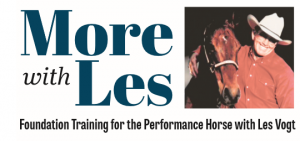 In the last couple of columns, we have covered a lot of detail. Here are some wrap-up notes to remember. (Find all “More With Les” columns at: http://bit.ly/HTmorewithles)
In the last couple of columns, we have covered a lot of detail. Here are some wrap-up notes to remember. (Find all “More With Les” columns at: http://bit.ly/HTmorewithles)
Teaching the horse to assume the stopping position
• Drive with the back legs, but keep front legs going
• Power comes from the loin
• To use the loin, back has to be round
• Neck has to be down for back to be round
• For the neck to be down it has to be soft!
How to create the ultimate collection is from the back to the front: Make the horse go and let them stop
Start at the walk: You want to stair-step up, and don’t be afraid to go back
Don’t make a big deal out of anything that you don’t want to be a big deal: If you go after a problem directly you will get the horse defensive
Creating the form for the collected stop
• Push the horse up, make her collect, then let off your legs to let her know she can stop
• But keep your hands going so she knows she can’t lift!
• If the horse even starts to lift or put any pressure on your hands drive them forward
• If they don’t, take them back a few steps
Clucking means to amplify energy—send it wherever you want to let it out
At Clinic
• Shows riders how to work the snaffle in coordination with legs
• Having to push the horse up, not as much work with all horses
• Use as much hand and leg as you need to get his attention and respect
Good negotiation: I get what I want. You get what you think you want. Use reverse psychology to obtain your goals
Should you kick or squeeze with your legs steady: At this point it’s easier to start with my leg and boot top. If you need more, just lay the spur on him and push. You can push it in pretty hard and then roll the spur rowel if the horse doesn’t respond. Bump with your boot tops, not with your spur. No gouging; it causes the horse to hold his breath and stiffen up; does more harm than good
Only once the horse gets “off ” the bridle and lets Les put a little “float” in the reins, can he think about letting the horse stop: If the head lifts, kick him forward again. If he doesn’t commit, back him up. How far? Until the neck is soft. Don’t stop moving your hands— you’re either going to kick him forward or roll him back so make sure to keep him soft in the bridle
Working on the collected stop
• Get the feel you want in the bridle first
• If you don’t like the feel in the neck, don’t stop
• Reward the little stuff when you get it
• Later on in your training, if your stops start to fall apart, this is where you’ll come back to
Sequence Stop: When a horse has a spot of resistance—somewhere in his stop; Slow the stop down, until you can find the part that’s causing problems. Give him three or four steps to stop. When he stays soft in the neck you can stop again. Now you can move ahead, and if it doesn’t work you can come back here again
Speed up one step at a time: Don’t move to the trot or lope until the stop is perfect at the walk. If you take your time now, it will pay off in the future. If you went about it without attention to the form, you’ll never maximize the horse
Points to remember
• Keep your hands moving
• Don’t even dream of stopping until you get the neck
• If he starts to lift, kick him forward
• As soon as you feel him start to lift, speed your hands up and kick him forward
• If he doesn’t commit, back him up until his neck softens
• You want them to melt into the stop
The collected stop might seem really primary: But this form is where the 40-footer comes from. It’s where you come when problems start to surface
–Les
Leave a Comment
All fields must be filled in to leave a message.